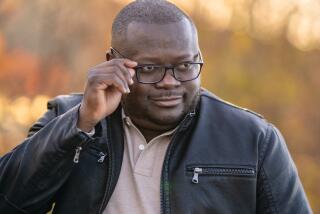BOOK REVIEW: NONFICTION : A Biblical City Rich With Activity, History : JERICHO b<i> y Robert Ruby</i> (Henry Holt; $25, 340 pages)
- Share via
Seen from a distant elevation, Robert Ruby remarks, Jericho and the irrigated land around it are a bright green postcard in the tan and dun of the Jordan Valley. To enter its crowded streets, humming with a dozen agitated conversations (“There were days when the only observable activity was the act of lingering”) and redolent with hot oil, spices and coffee, he writes, “always caused the colors to fade.”
Colors are for painters and tourists; they are activity at repose. Ruby has an excellent eye for them but they are not his main concern. He is a journalist who has applied himself to the present and past of the Palestinian town that Joshua, in the Bible, destroyed to forge passage for the Israelites; that was King Herod’s capital; and that is to become Yasser Arafat’s. He is dealing with history’s striving and contention, and the dust they throw up, obscuring all repose and color.
Ruby writes of a Bedouin shepherd who nudges his sheep to nibble the vegetables of the neighboring farmers. When an outraged farmer appears, the shepherd announces that he is helping Ruby--suddenly promoted to U.N. official--with an important mission.
He writes--this was before the accord that turned the administration over to the PLO--of the energetic and displaced Israeli colonel who commuted each day from Tel Aviv to act as civil governor. When he asked the colonel why the Arabs had to go from office to office to renew their driver’s licenses--the Israelis could do it by mail--the colonel replied that it was “so we can keep some contact day by day with the population.” Like house guests, occupations start to go bad after the third day and last, of course, longer.
Ruby writes at much greater length of the 19th-Century British explorers and map makers whose mission was to find physical confirmation of biblical events, and of 20th-Century archeologists whose diggings and datings put some of those confirmations in doubt. Jericho’s walls, it seems, must have collapsed 1,000 years before Joshua’s reputed arrival. He writes of the Natufians of 8000 B.C., whose remains form the bottom layer of the many Jerichos in the Ein Sultan mound just outside the present-day town, and of the repulsive conduct of King Herod and his appropriate demise by way of genital worms.
The author, who was Middle East correspondent for the Baltimore Sun, is an excellent writer. He has the journalist’s skill at evoking what he sees and hears; he lacks something of the biographer’s and historian’s skill at evoking what he has researched, reasoned out and guessed at. The present-day portions come off, by and large, better than the historical ones; in addition, he tends to switch too frequently and dramatically between present and past, and among different times in the past.
Thus, we start with the British army engineer, Charles Warren, in 1968. He is about to sink his pick into the Ein Sultan mound. We are told to freeze the image; after 20 pages of background, the pick descends. Considering what happens when it does, the device is excessively dramatic. Warren finds some brick courses, arranges some excavating, is unimpressed and moves on. Only years later do trained archeologists begin to uncover Jericho’s history.
The story of the Palestin Exploration Fund, founded in London in the 1860s for the purpose of “illustrating the Bible” by mapping the Holy Land, is well told. There are engaging portraits of the expedition leaders and the difficulties they faced. There is the tall, cadaverous Charles Drake, who won his spurs exploring with Richard Burton; and the short, volatile Claude Conder, a Royal Engineers officer nominally in charge but insecure in the face of Drake’s greater expertise.
Then there is the inscrutable Kitchener. He had been a school chum of Conder’s, who happily sent for him after Drake died of a fever. With “old Kitchie,” Conder felt securely seconded. Instead, he was elbowed aside. Ruby loathes Britain’s future hero of Khartoum, repeating the allegation that the Lord General used to pilfer from his weekend hosts.
“The kindest thing one can say about Herbert Kitchener--as a man, not as a military leader--is that he never let himself down,” Ruby writes.
The book’s best portrait is of Rashid Erakat, a courtly landowner. His grandfather was the last of the sheiks who, under the Ottomans, held “protection” rights for escorting tourists down to the Jordan. His father, under the British, became the region’s police commander. Whoever the authorities above them, the Erakats would always be authorities.
Erakat, a proud Palestinian, couldn’t stand the Jordanians who moved in after the British left in 1948, but he briefly served as an officer in their army. There was no question of serving Israel when it took the West Bank in 1967; instead, Erakat became a U.N. official for refugees--still, that is, in charge of his people. Ruby’s “Jericho” is a palimpsest; so are the half dozen Jerichos buried under the Ein Sultan mound; and so is the story of those who live in Jericho today.
More to Read
Sign up for our Book Club newsletter
Get the latest news, events and more from the Los Angeles Times Book Club, and help us get L.A. reading and talking.
You may occasionally receive promotional content from the Los Angeles Times.






